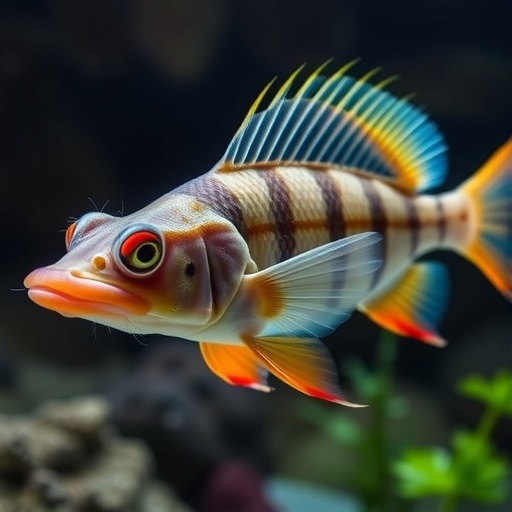In the complex and intricate tapestry of aquatic ecosystems, the survival and proliferation of species are deeply rooted in their metabolic adaptations. A recent study has illuminated the remarkable adaptability of the sailfin catfish intergrades, particularly in the context of their invasion successes in polluted tropical rivers. This research, spearheaded by an interdisciplinary team comprised of Rajasekaran, Ramar, Thangavelu, and their collaborators, delves into how a lipid-rich metabolome underpins the resilience and invasion capabilities of these fish under adverse environmental conditions.
At the heart of this investigation is the understanding of how metabolic processes influence species’ ability to adapt to stressors associated with pollution. In urbanized river systems, contaminants such as heavy metals, plastics, and organic pollutants pose significant challenges to aquatic life. The sailfin catfish, with their ability to thrive in compromised environments, serve as an exemplary model for studying the evolutionary impacts of pollution. This research highlights the biochemical pathways that contribute to their metabolic diversity and resilience.
Daily survival and thriving amidst pollution require the sailfin catfish to possess unique metabolic characteristics. Increased lipid production has emerged as a key survival strategy. Lipids, often viewed merely as energy stores, play multifaceted roles in organisms, functioning as essential components of cellular membranes and signaling molecules. This diverse function underscores the vital importance of lipids in metabolic pathways, particularly in species facing environmental toxicity and habitat loss.
The researchers conducted field studies and laboratory experiments, comparing the metabolic profiles of sailfin catfish from polluted rivers to those from pristine environments. Their findings reveal a startling difference between the two groups: the catfish inhabiting polluted niches exhibited a significantly higher concentration of lipid metabolites. These compounds not only enhance the fish’s energy reserves but also appear to provide protective mechanisms against environmental stressors. This insight opens the door to understanding how certain species may adapt to changing conditions while others languish.
Further analysis identified specific lipid compounds as being particularly abundant in the invasive catfish. Fatty acids, triglycerides, and phospholipids were prominent in their metabolic profiles. These molecules are integral in maintaining membrane integrity under stress and facilitating energy storage when food resources fluctuate. The research indicates that higher lipid levels may enhance metabolic efficiency, allowing these catfish to outcompete native species in shared habitats, thereby exacerbating biodiversity loss.
Additionally, the study underscores the role of the gut microbiome in lipid metabolism. Investigators found that the microbial communities residing within the digestive systems of sailfin catfish contribute significantly to lipid digestion and absorption. This symbiotic relationship may offer yet another layer of advantage, enabling the catfish to harness more energy from their diet, particularly in nutrient-poor waters altered by pollution.
The interplay between an organism’s lipid profile and its environment extends beyond mere survival; it has profound implications for ecosystem dynamics. As sailfin catfish thrive in polluted waters, they not only alter the balance of native fish populations but also influence the entire aquatic food web. Predators may shift their hunting patterns, and prey species may be forced to adapt or relocate, leading to cascading effects throughout the ecosystem.
Moreover, this research raises important questions about the future of aquatic biodiversity amidst climate change and increasing pollution. With many species struggling to adapt to these rapidly changing environments, understanding the metabolic adaptations of resilient species like the sailfin catfish is more critical than ever. These insights will serve as vital indicators of ecosystem health and sustainability, demonstrating how some species can triumph where others cannot.
Education and public awareness play pivotal roles in responding to these findings. Acknowledging the unique adaptations of species like the sailfin catfish can enhance conservation efforts and inform management practices aimed at preserving biodiversity. Campaigns focusing on the resilience of aquatic life in polluted environments could lead to greater understanding and support for river cleanup initiatives and sustainable practices.
This study is an essential reminder of the complexities of ecological interactions, particularly in human-altered landscapes. The intricate relationship between metabolism, adaptation, and environmental stressors exemplifies the need for interdisciplinary research that bridges ecology, evolution, and conservation biology. As the implications of this work ripple through the scientific community, it may inspire further investigations into how other species respond to pollution and ecological degradation.
In conclusion, the findings of Rajasekaran and his colleagues present a compelling narrative about the sailfin catfish’s success in polluted waters, driven by a lipid-rich metabolome. This study exemplifies the profound connections between metabolic processes and ecological outcomes, paving the way for future research that could illuminate the adaptive capacities of various species in the face of global environmental changes. Understanding these dynamics not only enriches our knowledge of ecology but also enhances our ability to shape a more sustainable future for our rivers and the myriad life forms they support.
As society grapples with the realities of pollution and climate change, findings like those presented in this study become cornerstones for fostering resilience in our natural systems. They remind us of the ongoing battles fought in ecosystems around the globe and the remarkable strategies organisms develop to thrive against the odds. Looking forward, it is imperative that we apply this knowledge to cultivate a deeper connection with aquatic environments and prioritize the health of our rivers.
Subject of Research: Metabolic adaptations of sailfin catfish intergrades in polluted river systems.
Article Title: Lipid-rich metabolome drives invasion success of sailfin catfish intergrades in polluted tropical river.
Article References: Rajasekaran, M.R., Ramar, S., Thangavelu, R.S. et al. Lipid-rich metabolome drives invasion success of sailfin catfish intergrades in polluted tropical river. Discov Anim 2, 81 (2025). https://doi.org/10.1007/s44338-025-00125-3
Image Credits: AI Generated
DOI:
Keywords: Sailfin catfish, lipid-rich metabolome, pollution, adaptation, ecological impact, biodiversity.




